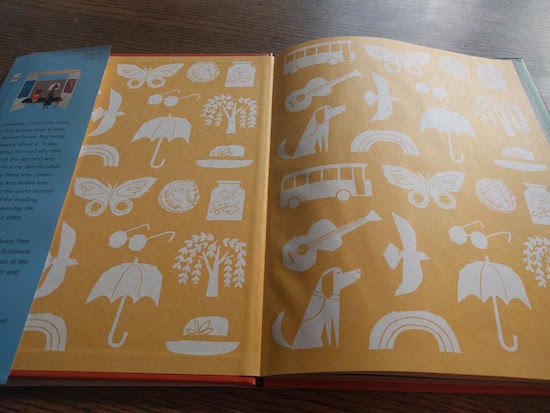April 22, 2016
Little Red, by Bethan Woollvin
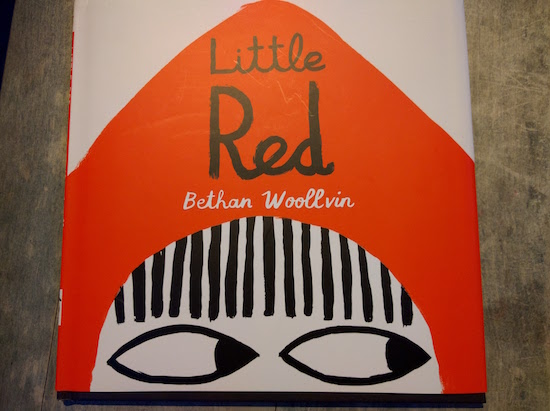
My big girl blew my mind this week with her “persuasive writing assignment,” about why the book Super Red Riding Hood should win the Blue Spruce Award through the Ontario Library Association’s Forest of Reading Award. “Firstly, it is a feminist book because it has a has a superhero who is a girl,” she wrote in her piece. “Secondly, it is cool and interesting because it has a great superhero. Finally, it is based on a fairy tale and full of suspense.” And of course because the best thing about fairy tales is one can never have too many versions of one, this week we were overjoyed to welcome Bethan Woollvin’s Little Red into the feminist Red Riding canon, a book that won the Macmillan Prize in 2014.

Woollvin’s illustrations reminded of Jon Klassen’s because while her style is very different, her approach is similar in its spareness, and also in how she uses her character’s eyes to provide emphasis to the understated text (which reminded me a lot in terms of rhythm and sentence structure of Mac Barnett’s in Extra Yarn).
And never ever has an illustrator put side-eye to such incredible use—Red Riding Hood’s facial expressions are magnificent.

In the author’s biography, we learn that this story was born out of Woollvin’s own problem with the Red Riding Hood Story when she encountered it in childhood: what kind of a moron would be taken in by a wolf in a nightdress? Surely Red Riding Hood was smarter than that?

And in this story, we see that she is. Red Riding Hood catches onto the Wolf’s preposterous posing as soon as any other smart, courageous girl does, and she comes up with a plan to deal with it on her own terms, no huntsman required. What transpires exactly between them is left up in the air, but we see Red Riding Home afterwards heading home in a wolf-suit—a most terrific homage of Sendak’s Max, I thought. It seems that girls can indeed be superheroes—and they can channel the ferocity of a wild thing too when it suits them.
Girl Power.

April 15, 2016
Happy Birthday, Alice Babette, by Monica Kulling and Qin Leng
If you loved Julia, Child, by Kyo Maclear and Julie Morstad (and who didn’t?) then you must feast your eyes on Happy Birthday, Alice Babette, by Monica Kulling and Qin Leng. Here is another autobiographical picture book about an admirable American in Paris, as Kulling tells the story of the relationship between Gertrude Stein and Alice B. Toklas. Monica Kulling’s picture books always come with a sweet subversive bent, and this one is no exception. Because it’s huge to see a lesbian couple depicted in a picture book, to see a female character who looks like a man and can’t be arsed in the kitchen (and when she is, it all goes wrong because she forgets to check the oven because she’s consumed by the composition of a poem), to see this example of a family (two women, no kids) because this is what Gertrude and Alice are, how they care for one another, each complementing the other’s strengths (though it’s true that Alice seems to have the patience of a saint).
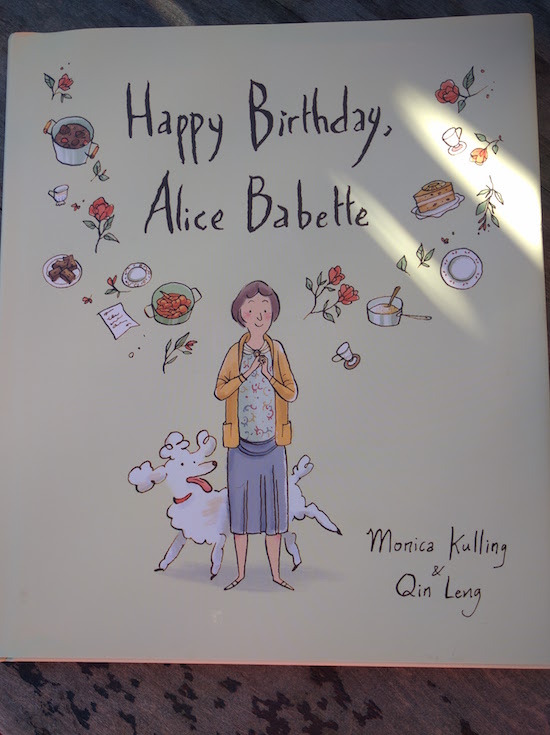
Although young readers will only pick up on all this subliminally. The children who pick up this book will be delighted by Qin Leng’s whimsical stylings (which we know from works like A Flock of Shoes) and this story of a woman named Gertrude and her friend Alice, whose birthday Gertrude becomes determined to mark in an extra-special way.
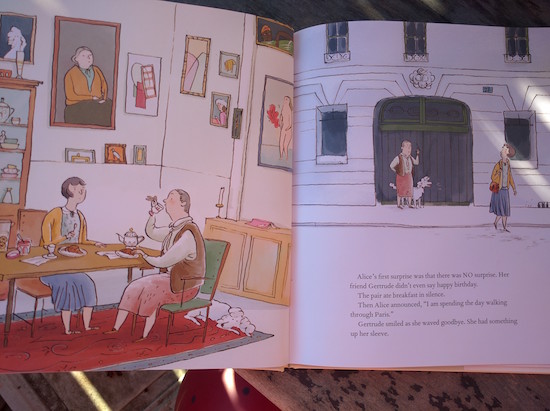
Although Gertrude says nothing of this in the morning as they eat their breakfast together, Alice announcing she’s going to spend the day walking around Paris, Gertrude with her own tricks up her sleeve.
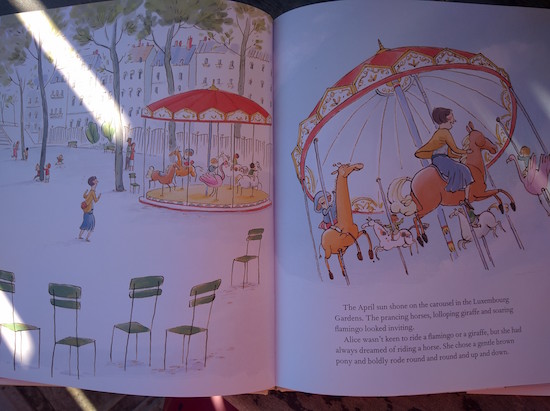
Alice has an eventful day just walking about, riding a carousel, watching a puppet show, and even diverting a would-be jewel thief as he attempts his getaway.

While Gertrude tries to execute her plan of making Alice a special dinner, and writing her a birthday poem. The latter’s inspiration comes easily enough as Gertrude buys a bouquet of roses from a flower seller and the ideas start flowing. Dinner, however, proves to be more of a challenge.

Gertrude does her best, even attempting to top it all off with a pineapple upside-down cake, but composing the poem turns out to be quite the distraction. So much so that she leaves the kitchen unattended, everything burnt to a crisp, Alice discovers, as she returns home from her “day of marvels.” And by this point Gertrude is lost altogether, busy at her desk turning her cooking misadventure into a story. Fortunately when their friends arrive for the party, they’ve got some food in tow and so Alice’s birthday can be properly celebrated after all—and Alice has made brownies for dessert (though it’s not clear whether these are her special ones).
It’s not a fair story, with poor Alice being left to clean up Gertrude’s mess, but then so often love really isn’t. Instead, this is a truer story about love and togetherness, and the myriad ways that two people can build a life together.
April 8, 2016
The Not-So-Faraway Adventure, by Andrew Larsen and Irene Luxbacher
Guess what? I’ve got an extra copy of this book to give to one of you. Anyone who signs up for my newsletter and/or leaves a comment on this post by midnight Friday April 17 will be entered in a random draw to win The Not-So-Far-Away Adventure, and I’ll mail it to the winner. Good luck!
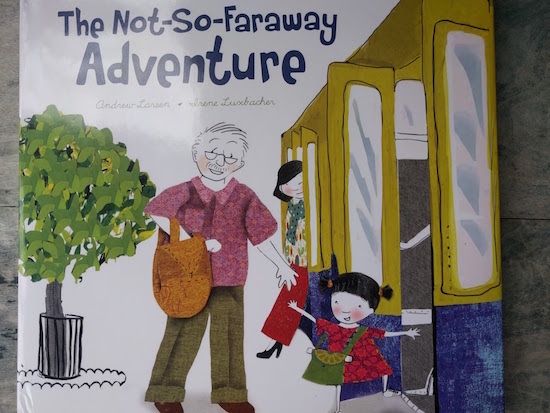
I’ve been looking forward to The Not-So-Faraway Adventure, written by Andrew Larsen and illustrated by Irene Luxbacher, partly because it follows up on the story of Theo and her grandfather from The Imaginary Garden, a book I first read (and loved) in 2011. At that point, I’d known Andrew lived in my neighbourhood, and I’d met him once at our local library (which is where he reconnected with kids’ books as an adult, attending library children’s programs when his son was young), but it was through my review of his book that we connected online and actually became friends. And in the years since, I’ve loved his books one after another (see last year’s See You Next Year), plus our children go to the same school now, so it’s always a good day when I run into him on the way to pick-up. I like his company just as much as I like his books.
And The Not-So-Faraway Adventure is no exception. It’s a story that takes as its premise one of the undercurrents of The Imaginary Garden, which was about a little girl and her grandfather who make peace with the small apartment he moves to after selling his family home. And implicit in the story was that Theo’s poppa had led a rich life—we see family pictures on his walls, and when he leaves part way through the story to take a trip (i.e. he has a life outside these pages) he packs his clothes in a suitcase covered in stickers showing all the places he has been.
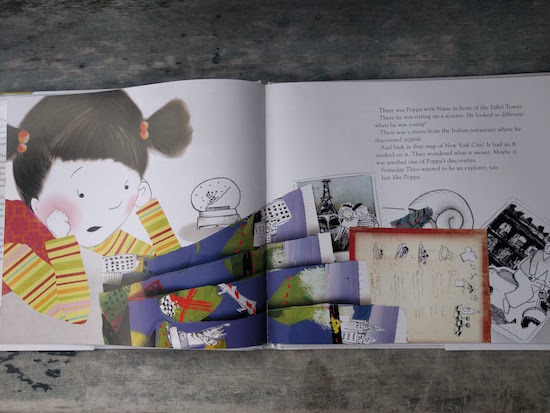
“Theo’s Poppa was an explorer,” begins The Not-So-Faraway Adventure. “He had been everywhere.” We learn a little bit more about him as Theo tells the reader about the contents of his trunk, which was packed with memories: “pictures, postcards, maps and menus that he had collected on his adventures.” Photos from Paris, maps of New York City, and “a menu from the Italian restaurant where he discovered zeppole.”
Inspired by the trunk, Theo decides to make a new adventure for her Poppa’s upcoming birthday. Together they devise a plan: a trip on the streetcar out to the beach. “There’s even a restaurant,” Theo tells him as they sketch a map of the places they plan to go. Theo is expanding her horizons as she plots their way out into the world, and Poppa delighting in connecting with his granddaughter as his own world has become a little smaller—but no less amazing, as their ensuing adventure proves.
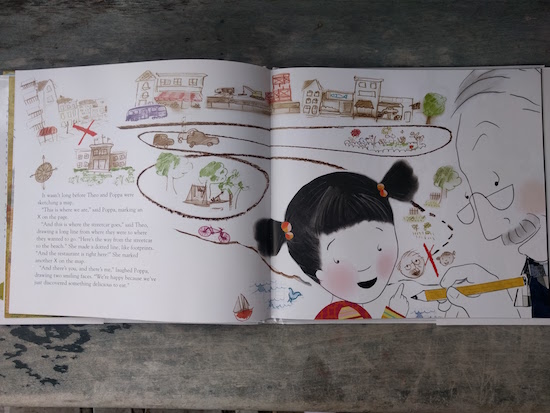
In addition to celebrating intergenerational ties, The Not-So-Faraway Adventures delights in city streets and city life, public transit and the sidewalk ballet. Luxbacher—whose work I love; see my review of her recent Malaika’s Costume—depicts a streetscape thrumming with people who wave back when Theo greets them from the streetcar. She passes “bookstores, bakeries, restaurants and schools,” which seems especially poignant to me as my local bookshop turns into a Chipotle and there’s one generic hipster pizza joint after another instead of stores that sell actual things. As always, I love the texture of Luxbacher’s illustration, her use of textiles and prints mixed with paints, all the florals, and I love her city’s architecture with its European bent.
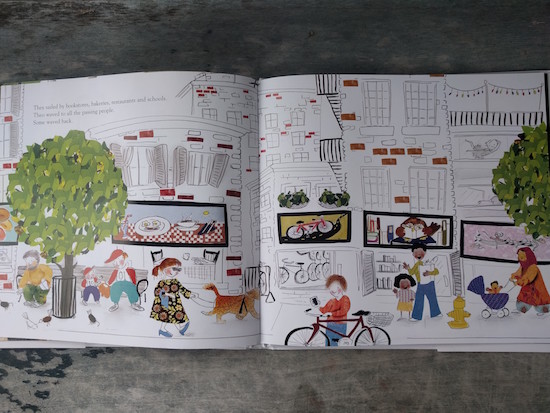
Finally Theo and Poppa arrive at the beach, where the water ignites their imaginations, they revel in the warmth of the sand on their feet, and order lunch on a patio and have the best gazpacho ever. ‘”And we discovered it together!” said Theo,’ which is my favourite part of the book, that they’re on the same level, the respect accorded to Theo by her grandfather, that he genuinely respects her as an individual, is never patronizing, is willing to follow her lead despite the years between them, and how she certainly loves him all the more for all of this. The mutuality of their experience, and the generosity on both these characters’ part: how much they want to give each other and how much they actually do (which manages to be even more).
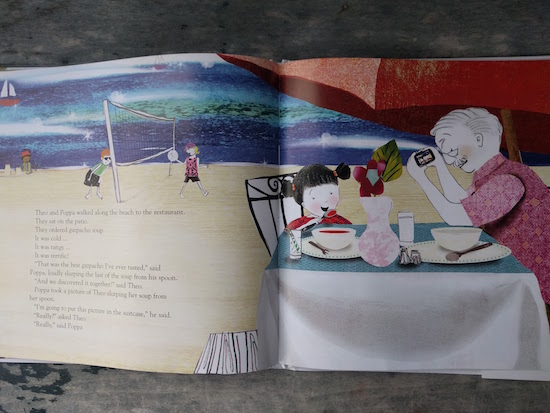
Theo and Poppa arrive home from their adventure to find a party waiting for them, cake and balloons and celebrations, but we know that this will not be the part of the story that either of them will remember. And to affirm this, Theo places the map of their journey inside Poppa’s trunk, finding a way to make his long-ago adventures seem less far away, a connection between past and present—and to insert herself into his fabled history as well.
As Larsen’s stories always do, this one celebrates the magic inherent in ordinary experience if you just have wonder enough to look for it. One never has to travel too far.
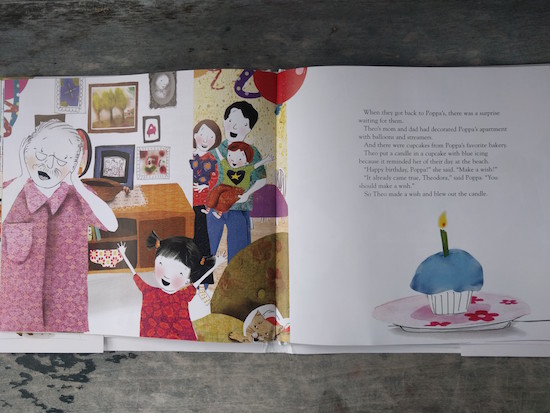
April 1, 2016
You Are One, by Sara O’Leary and Karen Klaassen

If you’re a friend of mine with a baby turning one this year, do NOT buy your wee one You Are One, by Sara O’Leary and Karen Klassen. Do not buy a copy of this delicious new book, because I’m going to be buying it for you. It’s the latest from O’Leary, who we fell in love with via the Henry books (When You Were Small) and last year’s This Is Sadie.
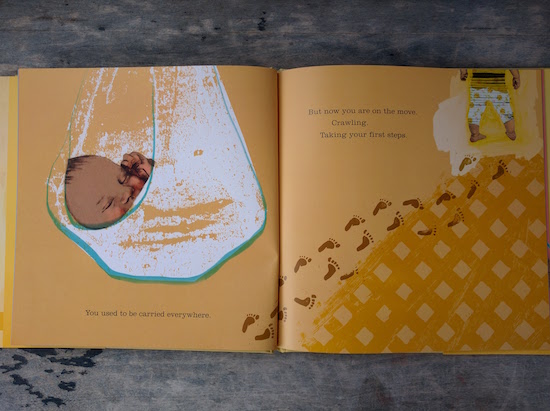
It’s the most perfect celebration of the milestones that mark that mind-blowing phenomenon that is a baby’s first year. A year in which a person starts out like a “pickled piglet” (in the words of Lorrie Moore) and is transformed into an actual human being with a personality, likes and dislikes, a sense of humour and sense of fun.
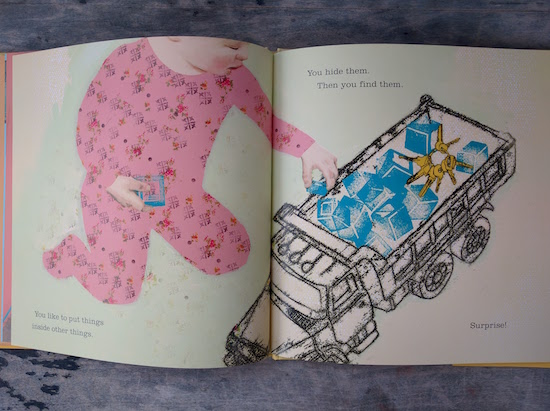
O’Leary has zeroed in on perfect details: babies liking to put things in things (and hiding the keys); the appeal of an empty box, not to mention that baby in the mirror; and talking in sentences (but not necessarily with words).
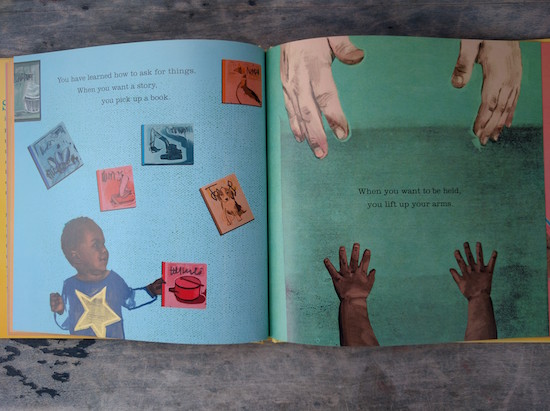
Klassen’s illustrations are stylish. interestedly textured, and feature a variety of images guaranteed to delight babies and the people who love them (i.e. check out the pudgy hands up above—and I love the racial diversity too). This book really will make the perfect for one-year-olds and their parents, and here’s the best thing: it’s the first in a series. Watch for You Are Two and You Are Three in the months ahead.
March 24, 2016
The Night Gardener and If I Had a Gryphon
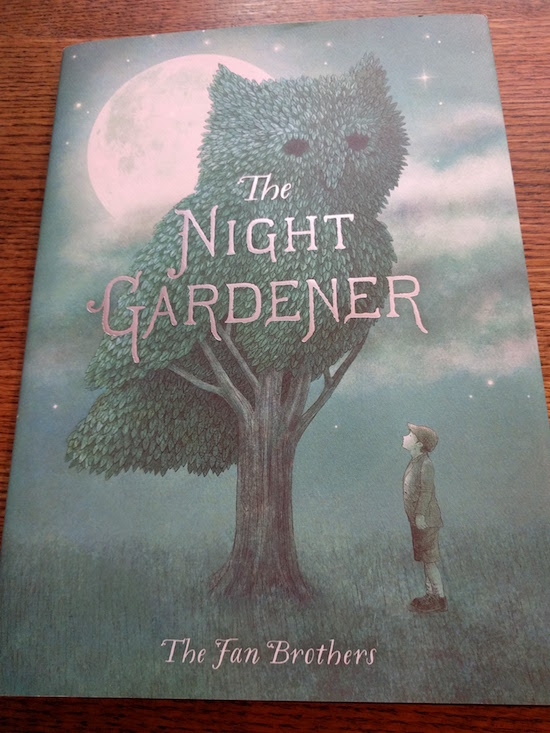 I wasn’t supposed to get a book at all, but then I ended up with two. These are the kinds of things that happen when one is me. The plan was to buy a book at Bakka Phoenix Books for Harriet’s friend who was moving away, but then I saw The Night Gardener by The Fan Brothers and also If I Had a Gryphon, by Vikki VanSickle and Cale Atkinson, and I had to have both of them.
I wasn’t supposed to get a book at all, but then I ended up with two. These are the kinds of things that happen when one is me. The plan was to buy a book at Bakka Phoenix Books for Harriet’s friend who was moving away, but then I saw The Night Gardener by The Fan Brothers and also If I Had a Gryphon, by Vikki VanSickle and Cale Atkinson, and I had to have both of them.
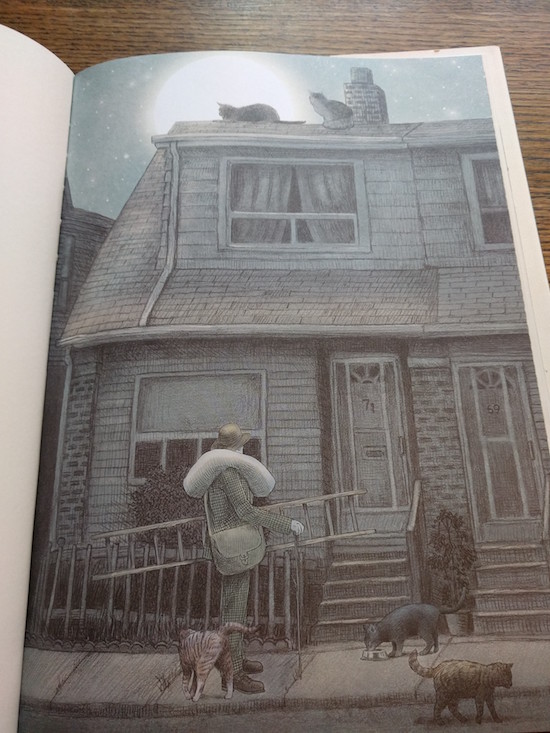
I have a weakness for books featuring Toronto-style houses (like Sidewalk Flowers, and another recent one I’ve seen is A Boy Asked the Wind), which is what drew me to The Night Gardener. Although I will admit to being confused to the story’s individual components: that the boy in the books lives in an orphanage, that the story exists outside of time that’s part Dickens, part contemporary; and there is something slightly sinister about the boy receiving a gift of a pair of secateurs. A lot of these concerns can be written off to magic, but it doesn’t seem entirely realized. What are realized, however, are the illustrations, ordinary trees reborn as creatures of all kinds, thanks to the work of a secret gardener who comes and goes in the night.
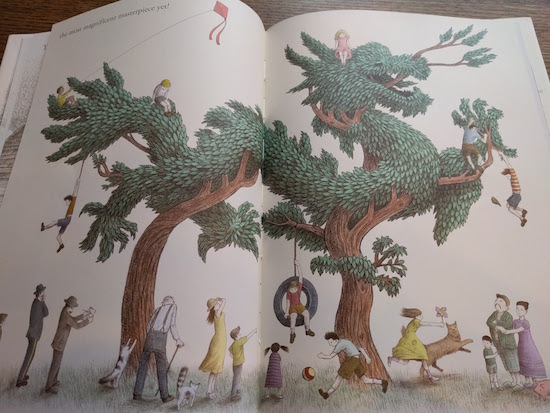 Anyway, the dragon in the above illustration brings me to If I Had a Gryphon, in which a small girl laments the mundanity of having a hamster for a pet. The book is written in rhyming verse featuring fun and playful illustrations, and we were immediately hooked.
Anyway, the dragon in the above illustration brings me to If I Had a Gryphon, in which a small girl laments the mundanity of having a hamster for a pet. The book is written in rhyming verse featuring fun and playful illustrations, and we were immediately hooked.
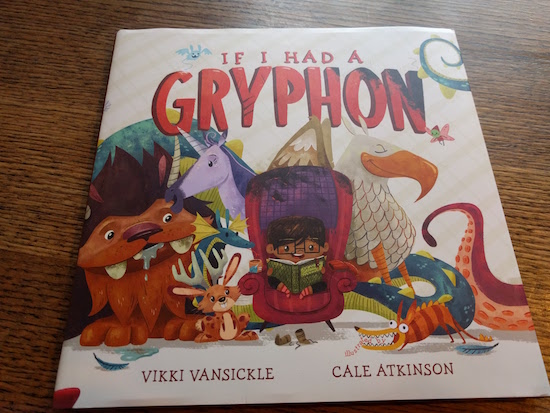
If I Had a Gryphon is a primer for future nerds, featuring allusions to a wide range of fictional creatures from myth and legend. Obviously, the little girl at its centre is a bookish one, and when she imagines alternatives to the hamster life, she’s not thinking ponies or cuddly kittens, but instead hippogriffs, sasquatches, or manticores.
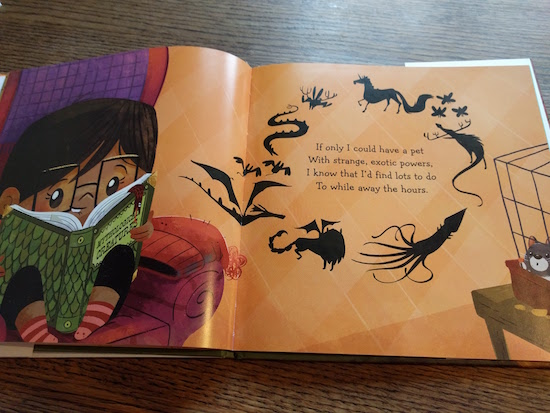
Thinking through her supposings, however, she realizes that mythical pets would actually be a lot of trouble (and that caring for them would probably cut into her time for reading).
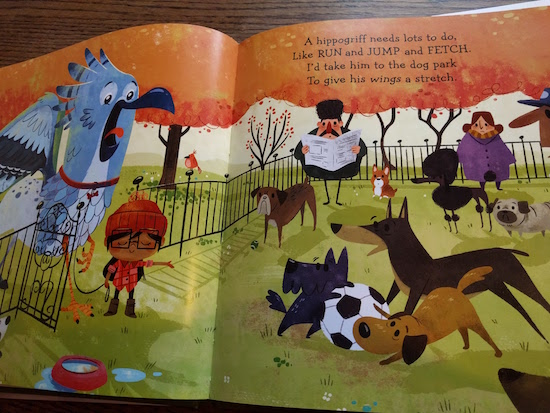
Clearly I’m not well read enough because many of the creatures in the book weren’t familiar to me: what is a kraken, after all, or a kiran, or a basilisk? Although such questions are the point I think, and this book serves as the perfect jumping off point for further exploration (as well as imaginary brand new, never-before-thought-of creatures). I don’t say this very often, but I think Gryphon might have benefited from a glossary to bring some of us up to mythical speed, although the internet will certainly suffice.
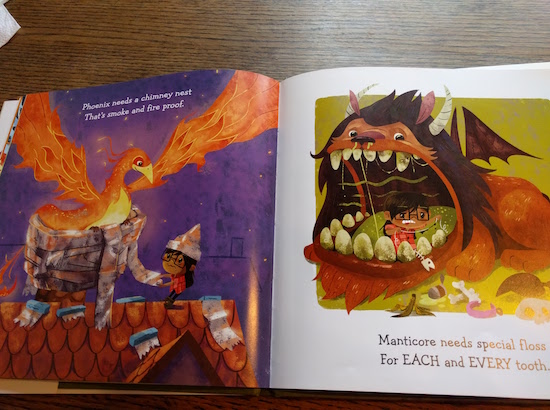
This book reminded of Julia’s House for Lost Creatures, by Ben Hatke, another picture book in which a tenacious girl has to contend with managing fictional beasts of all kinds. We love If I Had a Gryphon just as much, and every time we’ve read it, our delight in its final image has been absolutely. Just wait for it, and you’ll see what I mean.
March 11, 2016
Going for a Sea Bath, by Andrée Poulin and Anne-Claire Delisle
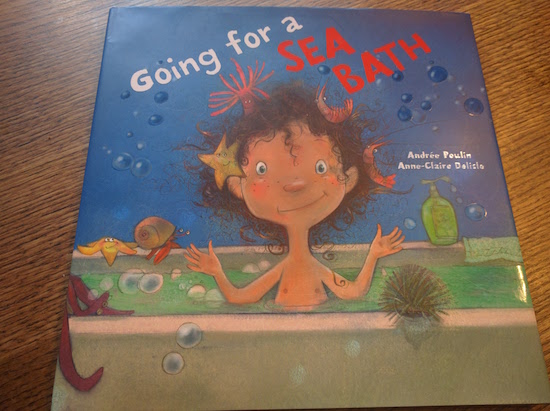
After a week sitting beside the ocean, it was a pleasure to return home to brand new book Going For a Sea Bath, by Andrée Poulin and Anne-Claire Delisle, and translated from French by Erin Woods. Although I’ll admit to being initially a bit wary of the book—as an avid reader of classic Canadian bath-lit, I’d noted a resemblance in substance and style to Eugenie Fernandes’ Waves in the Bathtub. But I was happy to find out that the resemblance is only skin deep, and while both titles make for excellent companion readers, Going for a Sea Bath is something all its own.
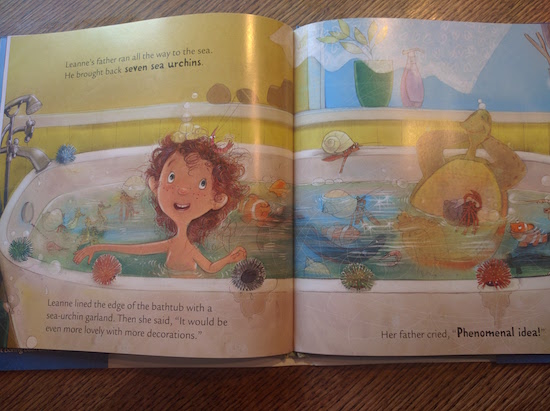
In terms of structure, pacing and general silliness, Going for a Sea Bath recalls early-Munsch. It’s the story of a little girl called Leanne who finds bath time too boring, and so her doting father runs down to the sea to find her creatures to liven up the tub. Beginning with a turtle, and moving onto eels, and anemones, urchins and clownfish, with eventually the marine menagerie becoming too much to handle—leading to the inevitable addition of octopi.
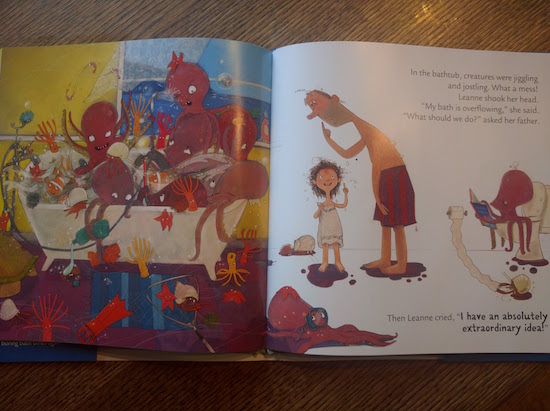
And by this point things are absolutely overflowing, but Leanne’s dad is not deterred. The page above, for obvious reasons (i.e. an octopus on the toilet, a hermit crab with toilet paper!—these perfect details in the illustrations feature throughout) is a favourite in our house, the point at which everything is totally out of control, and Leanne’s dad proposes they forego the bath altogether and jump into the sea, which is the most fun bath of all.

February 25, 2016
13 Words, by Lemony Snicket and Maira Kalman
I came to Maira Kalman by accident, which seems particularly Maira Kalman-esque, really. And now I am in love with her work, the themes and ideas she returns to again and again. I bought her picture book alphabet, Ah-Ha to Zig-Zag for my children (yeah, right, no, for me), and was overjoyed to find 13 Words, written by Lemony Snicket, in the library not so long. And loved that one so much that I had to buy it too.

I don’t know Lemony Snicket from A Series of Unfortunate Events as Harriet is averse to literary peril, but we are mystified by and simultaneously in love with 29 Myths On the Swinster Pharmacy. And then there is his picture book with Jon Klassen, The Dark. He promises weird and wonderful, and totally delivers.
From Publishers Weekly: “Based on an unlucky number of key words and authored by someone who takes pleasure in unfortunate events, this volume conjures a sense of foreboding.”
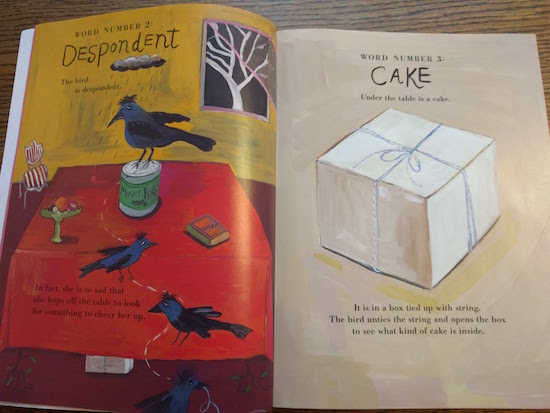
The premise is 13 seemingly random words and a story created around them. And this is not your usual word book. While there is “Bird,” “Baby,” and “Hat,” there is also “Despondent,” “Haberdashery,” and “Panache.” And yes, there is cake. Is there ever cake—even one of the bundt variety.
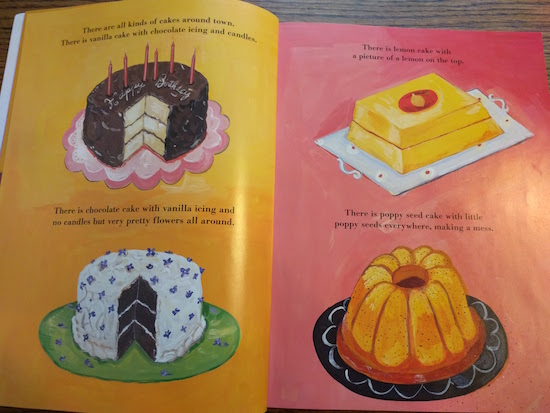
One thing leads to another, but to never quite what you think. There is a goat in a convertible and the bird starts painting ladders, and there are dishes in the sink.
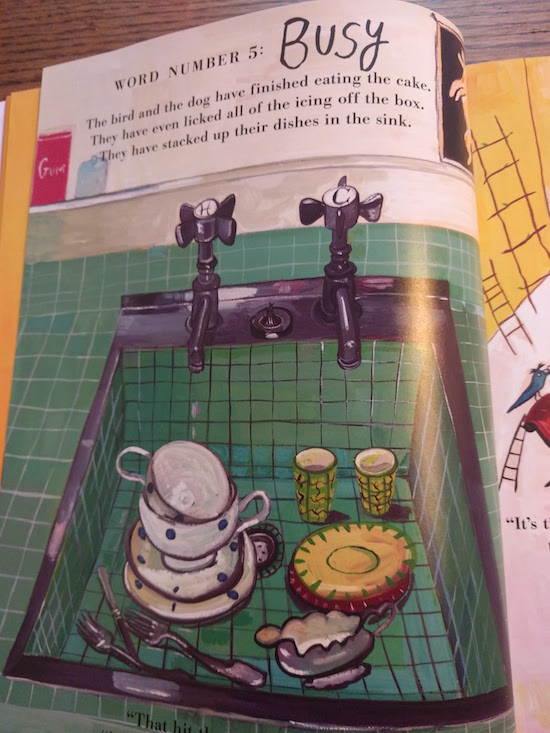
Kaman’s illustrations are so perfect here, every ordinary thing a revelation, full of magic, so that it doesn’t seem so strange to see, say, a giraffe behind the wheel of a car, a table sprouting vines, and or a baby minding a hat shop.
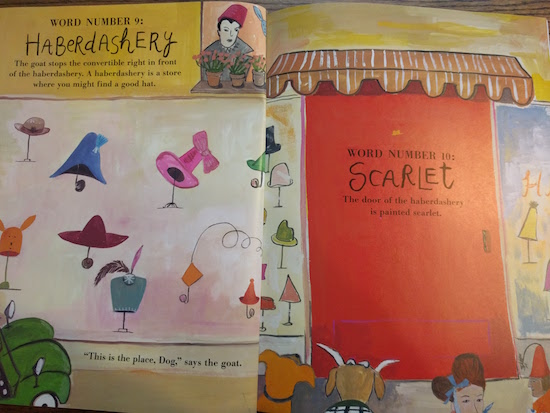
It doesn’t make sense, but the best things rarely do. And like all the best things, it ends with a party (with cake!) and a song.
Although even so, the bird is still despondent.
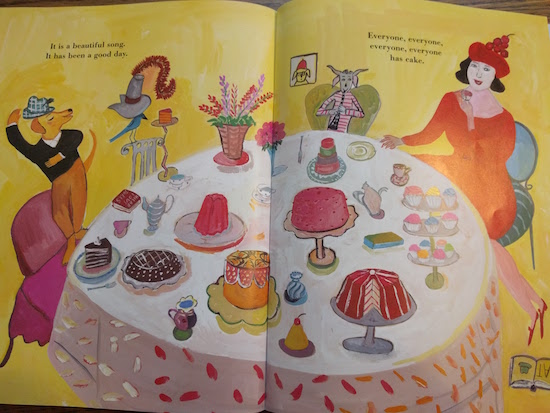
February 19, 2016
Dragonfly Kites, by Tomson Highway and Julie Flett
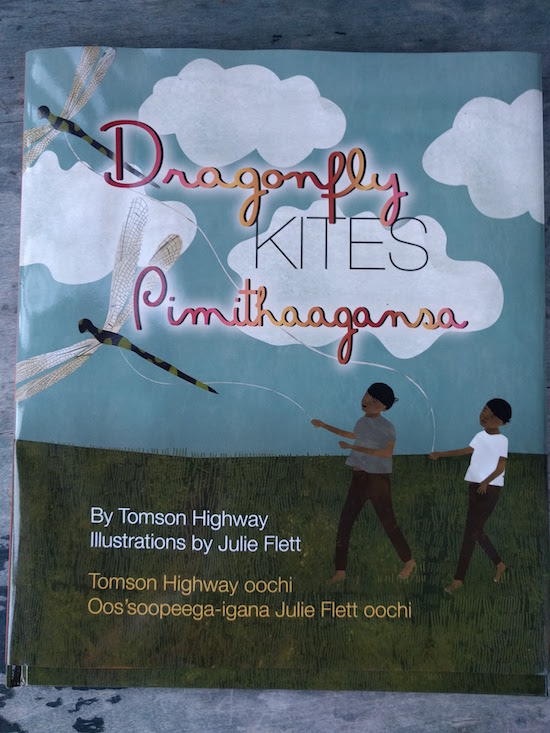
Just a week after bringing you a review of My Heart Fills With Happiness, by Monique Gray Smith and Julie Flett, I’m pleased to bring you another beautiful book illustrated by Flett. This one is Dragonfly Kites, written by Tomson Highway, who’s best known for his plays and works for adults (The Rez Sisters, Dry Lips Oughta Move to Kapuskasing, Kiss of the Fur Queen).
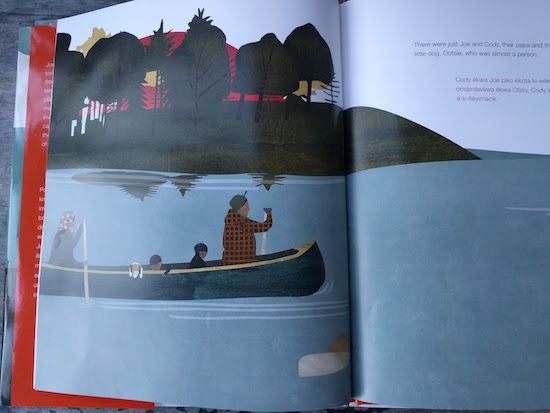
Like Flett’s illustrations, Highway’s story is gorgeous and simple. It features Cody and Joe, who appeared in his previous picture book, Caribou Song (and there is another in the works in this planned trilogy). The boys live with their parents in Northern Manitoba where there are so many lakes they’ve never stayed on the same one twice, and there are “islands and forests and beaches and clear water But no people.”
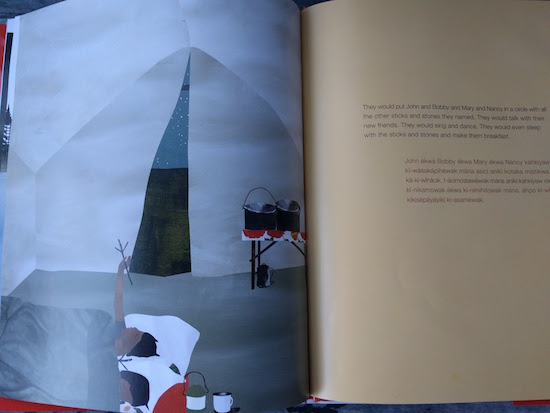
In this landscape, the boys make their own play, collecting sticks and giving them names, making up stories about the characters they become. (As we read this, I asked my city-dwelling children, “Do we know anybody who’d ever play a game like that?” and they both nodded, smiling at me.)
The story gives Flett the opportunity to do what she does best (and what she’s made a reputation for in books like Dolphin SOS, Wild Berries and Little You): beautiful scenes set in nature, highlighted with bright prints and patterns. Her talent shines in particular with her renderings of the dragon flies of the book’s title, with the gorgeous intricacies of their wings.
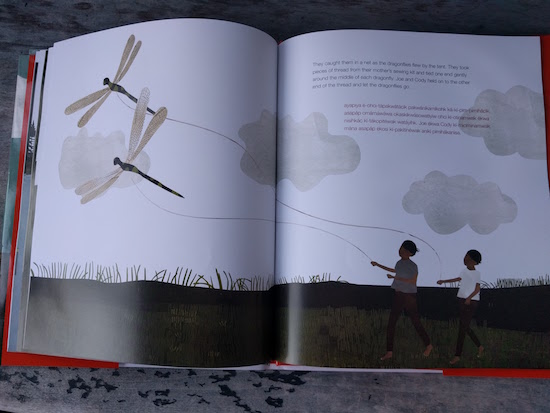
Joe and Cody name and play with many animals they encounter in the wild, but the dragonflies are their favourite. They catch the dragonflies in nets and tie threads around their middles, holding the strings with the dragonflies flying like kites. Which is the point at which the book really takes flight, and I’ll own up to googling “dragonfly kites” to find out if this is really something people do, and I don’t think it actually is, but that Highway made me wonder is a testament to this book’s magic. The dragonflies’ flight continuing long after the boys are tucked into bed at night, continuing on in their dreams, and now they’re soaring high with the insects, into the sunset, straight on until morning.
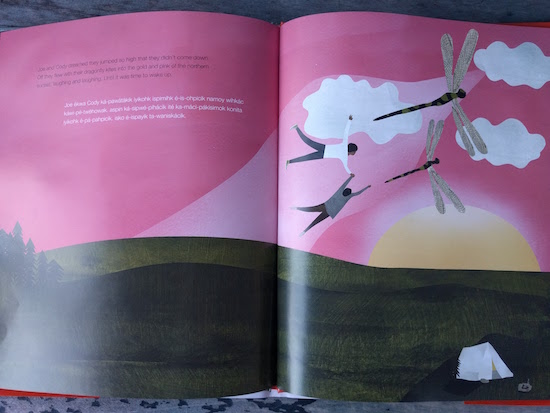
“That was a good one,” said Harriet when the story was over, the flight was done.
February 12, 2016
My Heart Fills With Happiness, by Monique Gray Smith and Julie Flett
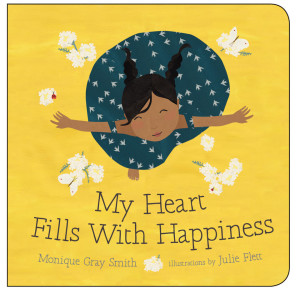
As the world’s biggest fan of Little You, the board book by Richard Van Camp and Julie Flett, I’m particularly excited about Flett’s latest work, My Heart Fills With Happiness, a board book written by Monique Gray Smith (whose novel, Tilly, was winner of the 2014 Burt Prize for First Nations, Métis and Inuit Literature). “This book is dedicated to the former Indian Residential School students and their families—may you find what you seek,” reads Smith’s dedication, and her text is a celebration of First Nations culture as well as those perfect moments of exuberant joy that might be noted as ordinary if they weren’t so extraordinary (and perhaps the key to happiness lies in knowing that distinction): when you see the face of someone you love, smell bannock baking in the oven (with a teapot in the illustration; and oh, do I ever want to bake bannock now), when you’re dancing, singing, or holding the hand of someone you love. “What fills YOUR heart with happiness?” the book asks as it ends.
I received an advanced copy of My Heart Fills With Happiness back in December when I’d been ill in bed for weeks, and I recall reading it with Iris one afternoon while we were home alone together. It was late afternoon and the west-facing window in my room was poured through with sunlight, as yellow as this book’s beautiful cover. We were lying in my bed, face to face, and prompted by the book’s final question, we started talking about the things that fill our hearts: cake, and sunlight, and hugs, and books. The first proper conversation we’d ever had, it occurred to me, as her brain had undergone some transformation rather suddenly (she’d just turned two and a half) and now was (kind of) a creature capable of communicating complex ideas: she looked at me and said, “The sun makes my window so open.” And I knew exactly what she meant.
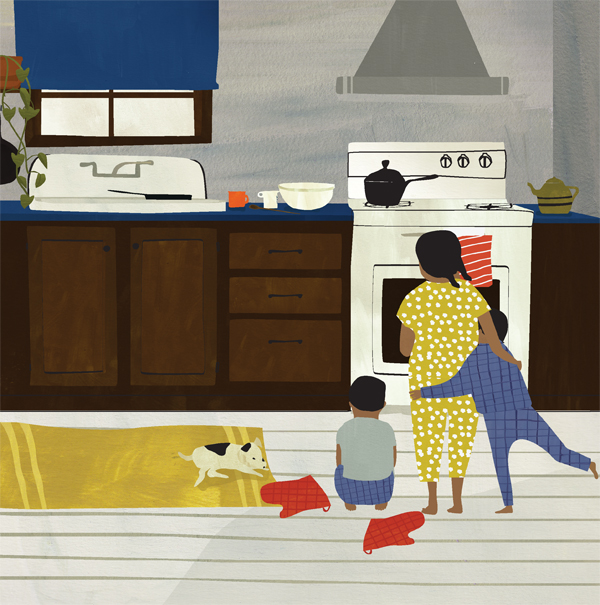
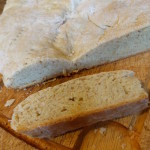 UPDATE: Bannock happened! We baked it this morning and the smell is indeed one that would fill your heart with happiness. Delicious. We happen to have leftover Devonshire cream in the fridge as well as strawberry jam, so my heart is basically exploding (and not just with cholesterol). I got the recipe from here.
UPDATE: Bannock happened! We baked it this morning and the smell is indeed one that would fill your heart with happiness. Delicious. We happen to have leftover Devonshire cream in the fridge as well as strawberry jam, so my heart is basically exploding (and not just with cholesterol). I got the recipe from here.
February 5, 2016
Last Stop on Market Street, by Matt de la Peña and Christian Robinson
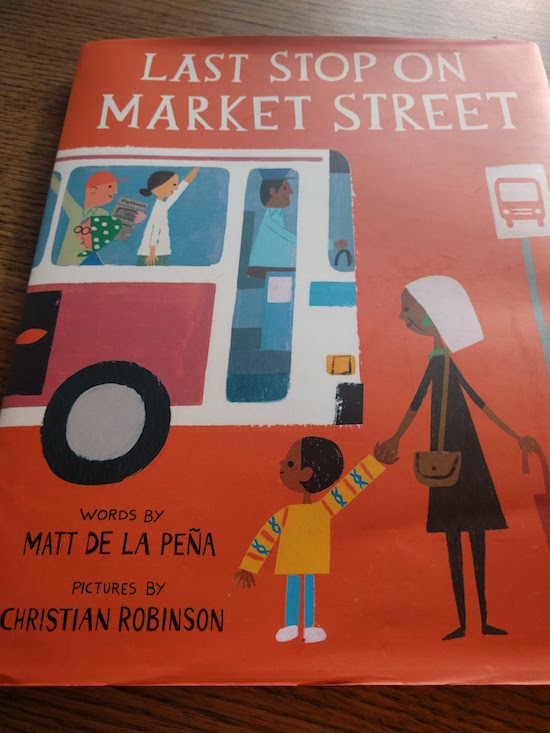
I’ve been spending a lot of time lately thinking about the nature of an imperfect world, about the gifts inherent in that kind of reality. (The only kind of reality.) That accepting the imperfections and imperfectability of the world is not about giving up hope of making things better, but instead the reason why we mustn’t stop trying—where would we be if we did? And how other people keep us in check—even the assholes. Well-being lies not about improving the assholes, obliterating assholedom, but instead learning to live among them. Accepting too that everybody is someone else’s asshole sometime. It’s all a negotiation, this business of daily life in the world. Even negotiating with those people who will never understand that.
I read an article last weekend about a teacher remarking on her high-needs students: “There are a lot of kids here who keep life interesting.” I’m aspiring to maintain such a perspective on my fellow humans, the challenging ones.
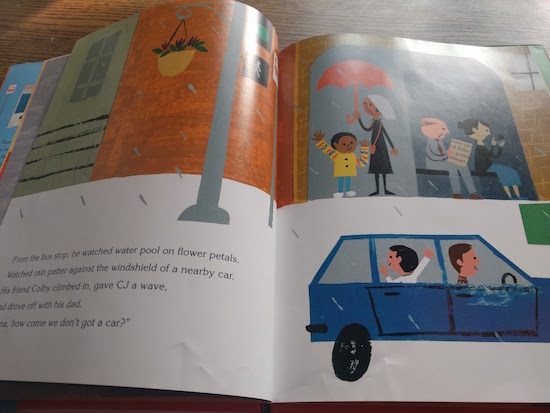
A gift of living in the city and especially raising my children here is that the world’s imperfections are always close at hand. Garbage in the gutters, mentally ill people shouting obscenities in the streets, mentally sound people shouting obscenities in the streets, someone threw up on the sidewalk, drivers nearly bowling us over turning right on red lights, ugly graffiti sprayed on beautiful murals, and people who vape. Here is the world…and yet we love it anyway. Perhaps even more so. Because there’s also bees alighting on flowers, little kids holding their parents’ hands, squirrels eating sandwiches, cherry blossom springtimes, the wonder of an airplane soaring overhead, and music, and finger paint, and dancing to “Trouble” by Taylor Swift. It’s the same reasons we take to read Grimms’ fairy tales at their gruesomest: because here is the world…and yet.
The city in Matt de la Peña and Christian Robinson’s Newbery Award-winning Last Stop on Market Street is San Francisco which, by virtue of its density, is a city of contrasts. We see this as CJ and his Nana board the bus on Sunday after church and make their way across town for a weekly appointment. CJ wonders why they have to go. He wonders why they can’t travel by car, like their friends who passed while they were waiting at the bus stop. But his Nana reminds him of the advantages of riding “a bus that breathes fire” (there is a dragon on the advertisement on the bus’s side), and of the people they’ll meet, the stories CJ will encounter on his way.
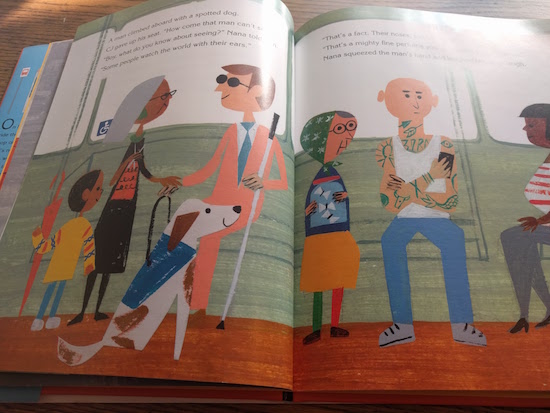
She’s proven right too, CJ’s Nana, knitting as they go, making friends with the man with the seeing-eye dog, convincing the man with guitar to break out in song—to which CJ closes his eyes and launches into a reverie, all butterflies and rhythm and moonlight. When the song ends, CJ tosses a coin into the man’s hat and suddenly they’re at their destination: “Last stop on Market Street!”
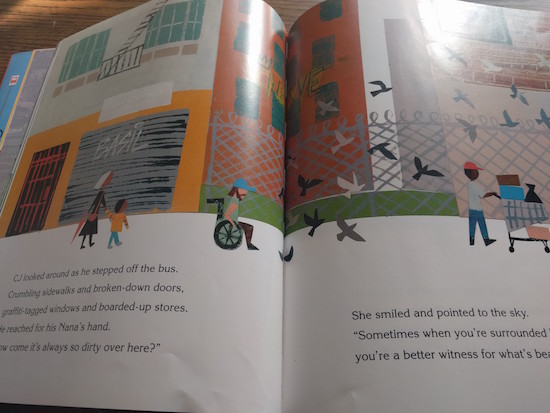
CJ is still not sure as he steps off the bus, taking his Nana’s hand. It’s a rough neighbourhood with boarded up shops and graffiti. The only birds are pigeons. His Nana points to the sky though: “Sometimes when you’re surrounded by dirt, CJ, you’re a better witness for what’s beautiful.” And in the following spread we see a bigger picture, a rainbow overhead. “He looked all around them again,/ at the bus rounding the corner out of sight/ and the broken streetlamps still lit up bright/ and the stray-cat shadows moving across the wall.”
The subtle rhyme of de la Peña’s prose gives the story a kind of music, rhythm and cadence. The journey culminates with CJ and his nana’s arrival at the soup kitchen where they work every week serving lunch to the people of the neighbourhood. People who are people in their own right: Esther with her new hat, and the Sunglass Man. And CJ tells his grandmother that he’s glad they came.
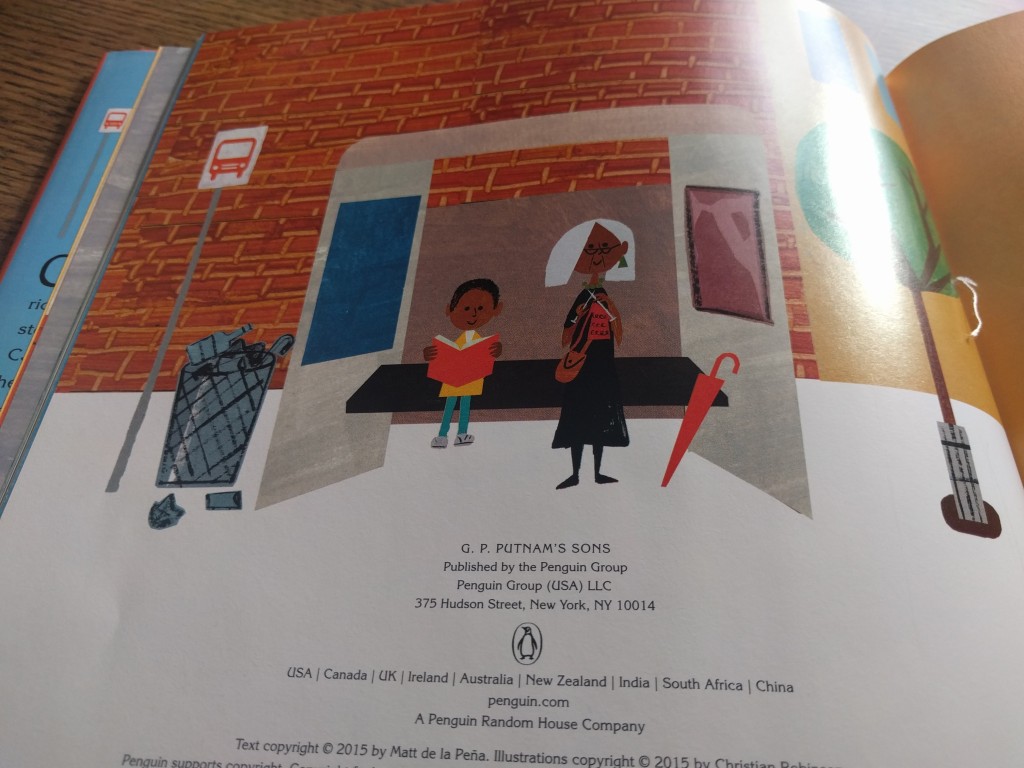
The story concludes with CJ and his nana back waiting for the bus, with caged spindly trees and overflowing litter bins, but the beauty’s there: we see it now. Perhaps it’s been there all along.
